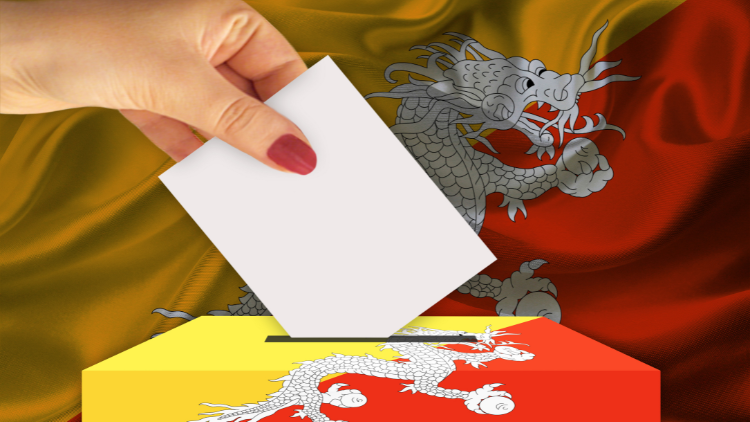Bhutan
Bhutan chooses experience over change

Elections in Bhutan - Voting Ballot
© FNF South AsiaIn the fourth general election held on January 9, 2024, the People’s Democratic Party (PDP), Bhutan’s oldest political party, returned to power for the second time in the country’s 15-year history of democracy. PDP clinched a convincing win by securing 30 out of 47 seats in the National Assembly. Bhutan Tendrel Party (BTP), the newest party in the race, was able to garner 17 seats. A party needs to secure 24 seats to form the government. PDP and BTP had emerged as the top two parties in the primary election held on November 30, 2023. Five political parties had contested in the primary election which saw the exit of Druk Phuensum Tshogpa after 15 years in Parliament; Druk Nyamrup Tshogpa, the former governing party; and Druk Thuendrel Tshogpa, a relatively new entrant.
What one needs to understand is that elections to the National Assembly in Bhutan take place in two stages – the primary election which is then followed by the general election. Only those political parties that are registered at the Election Commission are allowed to contest the primary round. The two parties with the highest number of votes in the primary election are then eligible to contest in the general election, following which the party that wins more seats forms the government with the other party forming the opposition.
During this year’s election, economic recovery was at the heart of the manifestoes of all the parties. PDP promised to ‘rescue’ the country's economy through a Nu 15 billion economic stimulus plan. It also pledged to license private television companies to operate, which will give the media landscape in Bhutan a huge boost. BTP pledged to create a vibrant economy by promoting economically competitive and environmentally friendly rural and urban enterprises. Issues related to the exodus of Bhutanese to foreign countries, particularly Australia, for education and employment, were vigorously debated in the run-up to the election. The exodus comes at a time when the country’s fertility rate has dropped to 1.8 births per woman in 2022 from 6.6 births per woman in 1971.
The election, with 65.74 per cent voter turnout, revealed two specific patterns - Gender Equality or rather Inequality and Regional Divide. Only two female candidates – one each from BTP and PDP from a pool of six female candidates – were able to win in the election. Both parties had fielded three female candidates each. In the new National Assembly, two female MPs will account for only 4 per cent of the Lower House. Electing women to power has always been a huge challenge in Bhutan despite 46.79 per cent of the population and 50.8 per cent of the voters being women, thanks to its patriarchal social setup. Among the five eminent members that His Majesty the King appointed to the 25-member National Council, the House of Review, two are women, taking the number of women to four or 12 per cent of the House.
Another pattern that was starkly visible was the regional divide among the voters. BTP, whose president hails from eastern Bhutan, swept 16 out of 17 constituencies in the six eastern districts. PDP, whose president is from western Bhutan, swept the whole of western Bhutan and other regions. As the PDP has secured the majority to form the government, there is now a real possibility of the entire eastern region being left out without any or only a single minister in the new government. The region will have only one MP in the governing party. In the last government, the eastern region had three Cabinet ministers. In its attempt to elect a government led by a prime minister from the east, the eastern region has lost both the government and ministerial positions.
This stark regional divide highlighted by the voting pattern has raised concerns among the general Bhutanese populace. Dividing the small society along regional lines, referred to as ‘regionalism’ in Bhutanese political parlance, is cautiously prevented in Bhutan to the extent that political candidates avoid it as a topic of debate.
The new government to be formed by PDP will now have two daunting economic tasks in the days ahead: to create gainful economic opportunities not only to retain Bhutanese in the country but also lure back those Bhutanese living and working abroad, and to secure most of the Nu 512 billion to implement the 13th five-year plan, which is by far the biggest in the country's history. The new government will also have to work towards securing resources for the recently announced ambitious megacity (of 1,000 square-kilometers), which is a carbon-negative special economic zone named ‘Gelephu Mindfulness City’. When it comes to foreign policy, the new government is not expected to bring in any drastic changes. India will continue to remain the most important foreign partner of Bhutan.
To sum up, Bhutan opted for experience, choosing the tried and tested leadership of 58-year-old Dasho Tshering Tobgay over the promising new party led by 56-year-old Dasho Pema Chewang in this year's election.
